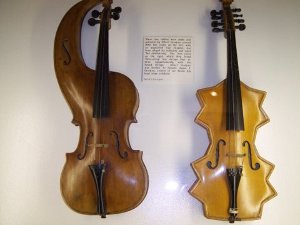In the lawless days of Prohibition, Lima was the center of a major
criminal case: John Dillinger was in the jail, and his gang came to the jail
pretending they were going to transfer him to another prison. When the
sheriff demurred, he was murdered, which led to a major manhunt and
ultimately the dismantling of the Dillinger Gang.
Like too many other Midwest small towns, Lima, Ohio, has areas of blight:
Big old houses with boarded windows, vacant lots filled with weeds and
 Altstaetter Band display
trash, too many empty stores downtown. The Ford plant has stopped making
their V-8 Truck engine here, but is still in business. There are several
large empty factories near the edge of town. But the people are
friendly,
helpful and upbeat.
Altstaetter Band display
trash, too many empty stores downtown. The Ford plant has stopped making
their V-8 Truck engine here, but is still in business. There are several
large empty factories near the edge of town. But the people are
friendly,
helpful and upbeat.
Scouting about for a significant Lima experience, we learned that the
Allen
County Museum is the only county museum in Ohio to be recognized by the
American Association of Museums. It is housed in a large brick building,
just next door to the McDonnell House, a fully restored Victorian home,
and
just in front of the Children's garden, on a block of older, pleasant
buildings near downtown Lima.
We began our tour by admiring a shining old horse-drawn hearse, buggy and
carriage, then a bright red Locomobile and artifacts from the old electric
railroad and interurban cars which formerly ran across northern Ohio. A
broad platform held wooden scale models of perhaps two dozen homes which
used to grace the Lima boulevards; most have since been torn down, but the
model builder has supplied notes of their history (doctors, mayors,
merchants lived there).
Other exhibits included some of the uniforms worn around 1900 by the Jacob
Altstaetter family band: father, mother, their four daughters and eight
sons, who entertained at social events. Next, a case displayed two
strange-looking violins along with the message that both had been played
by
professional musicians -- the one on the left was pronounced "not
satisfactory" while the other was "interesting".
As we wandered from room to room, we found something in each area to
enjoy.
The staff has been careful to select the unusual and significant items,
with
an eye to attracting adults as well as children.
A summary of the Dillinger trial is included, as well as special exhibits
of
some of the more noteworthy past industry -- everything from making cigars
to producing and selling a system for rapidly filling communion cups. The
requisite medical exhibits include an array assembled by two physicians of
objects removed from larynxes, esophagi, and stomachs of townsfolk large
and
small.
But by far our favorite exhibit was Noah's Ark. In 1892 James Grosjean
moved to Lima and set up an undertaking business. By 1902 he had set up a
shoe store downtown, and by 1920 he started the Lima Cord Sole and Heel
 Not Satisfactory and Interesting
Company which he managed until his death in 1938. Grosjean's true love,
however, was model-making.
Not Satisfactory and Interesting
Company which he managed until his death in 1938. Grosjean's true love,
however, was model-making.
He built Noah's ark to tell the Biblical story of the return to dry land
of
the animals after the ark landed on Mount Ararat. He put his display in
his
shoe store, and every child who purchased a pair of shoes was entitled to
watch the performance: first a window opens and a raven "flies" across
the
stage on a wire, then the dove with an olive branch appears, after which
the
big doors open and the animals, two by two, come down the gangplank and
disappear into a convenient hill. The humans disembark two by two, also,
and we see Noah and his family praising God. A small window below the
stage
allows spectators to see part of the assembly of pulleys and chaines which
operates this complex piece of machinery. The musical recording was added
later by the museum staff.
In short, there's enough here to attract just about any curious soul, and
while we can't recommend a lengthy visit to Lima, we certainly encourage
travelers to pause for an hour or so at the museum.
 Altstaetter Band display
trash, too many empty stores downtown. The Ford plant has stopped making
their V-8 Truck engine here, but is still in business. There are several
large empty factories near the edge of town. But the people are
friendly,
helpful and upbeat.
Altstaetter Band display
trash, too many empty stores downtown. The Ford plant has stopped making
their V-8 Truck engine here, but is still in business. There are several
large empty factories near the edge of town. But the people are
friendly,
helpful and upbeat.
 Not Satisfactory and Interesting
Not Satisfactory and Interesting